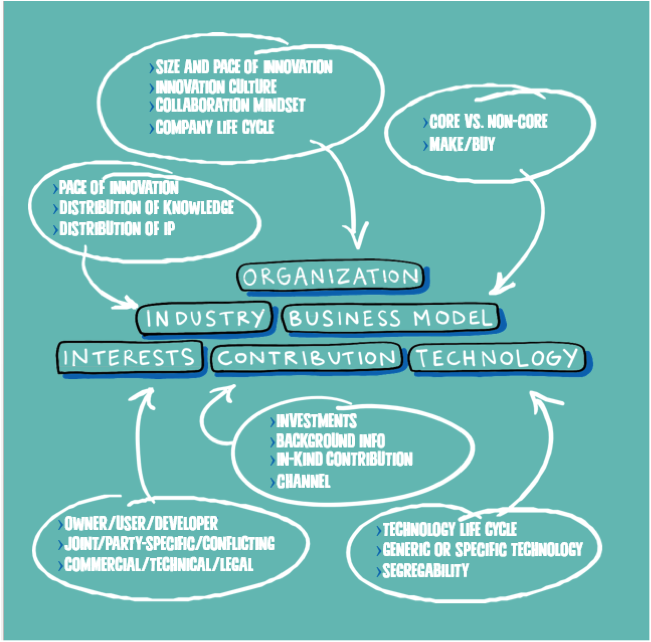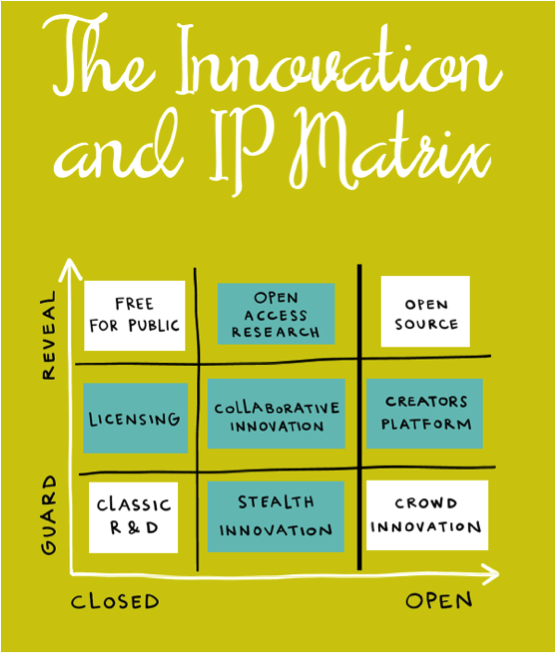3 moves to design a winning strategy!
A strategy for collaboration, particularly when innovating together, must consider the manner in which Intellectual Property is distributed within such a collaboration. In this blogpost we share some tools and tips on how to build a tailored, simple to understand IP strategy which enables you to get more out of partnerships and in capturing the value of innovation in a mutually beneficial manner for all parties involved.
In today’s global business world, robust collaborations for innovation supersede the concept of a lone genius. Apart from the obvious benefit of bringing together the best minds to innovate, organizations wish to mitigate the risks encountered in terms of heavy time, resource, and commercial investments in innovation by distributing them between several parties working towards a shared objective. While organizations are keen on cooperating with externals, often they do not know how to deal optimally with their own knowledge and intellectual property in such collaborations (see Dutch Periodic policy evaluation – Intellectual Property Policy). They encounter pressing questions like:
- Would we risk losing our crown jewels to parties we cooperate with and would our interests still be secure in collaborations?
- How do we distribute rights in and access to what we will develop together?
- How can we derive the best value out of the collaboration and our innovation commercially and/or socially?
Intellectual Property (IP) is the common thread running through the above questions. A tailored, simple to understand IP strategy can enable one to get more out of partnerships, and in capturing the value of the innovation in a mutually beneficial manner for all parties involved, without risking their investments, team resources, knowledge, and ultimately their goal.
There are 3 moves that can help you build such a strategy: Think – Strategize – Act
Think: Firstly, understand your business, strengths and needs in the context of your innovation using the six building blocks. An analysis using these building blocks – sometimes along with your collaboration partners – will enable you to lay down the foundation for your innovation and IP strategy.

Strategize: Secondly, define your collaboration using IP as a tool to address:
- How many parties are you going to work with and in what manner?
- Where are you willing to guard your IP and/or reveal it to others?
- How will you distribute IP within the collaboration and how can it support you in accelerating your business model?
Collaborations can be of different kinds. For example, when you collaborate with a partner, you can choose to have a ”classical” defensive approach to some parts of your IP and innovation, while on the other hand you openly exchange knowledge and IP in some other parts. It’s crucial to know what you want to open up and why, and if you choose to be defensive, also understand why you choose to be so.

The Matrix gives an overview of nine possible innovation & IP strategies. The x-axis of the Matrix represents how many parties you can work with – open versus closed innovation. The y-axis represents the approach taken towards IP: whether the organization guards their IP, licenses it to some or instead reveals it to many. The four corners of the Matrix are the extremes. The cross or the mellow middle is where organizations can get creative in their approach to Innovation and IP. There is no right or wrong approach. The most successful organizations often combine two or three strategies from the Matrix instead of just applying one strategy for one product or service, based on the organizational context and the innovation/business goals.
ColorADD developed a code for a colour identification system to help the colour blind. Their business model is based on two pillars: a pro bono licensing system (for free) for use of their code in the education field and sale of the code through license fees for all other markets. ColorADD’s strategy is based upon the impact and use of their product in a market. Is it their interest to diffuse their code as much as possible in the education channels, and through that have it known in other markets too? Is the social impact the highest in the field of education? And/or does the diffusion of their code via education boost their business model to make profits via license fees in other markets? The answers to these questions have determined their strategy!
NASA’s Centennial Challenge is crowd-sourced innovation ”to stimulate research and technology solutions to support NASA missions and inspire new national aerospace capabilities.“ Their 2021 Deep Space Food Challenge is offering prize money and/or recognition for winners. The winners will own IP rights on their contributions with the option to discuss licensing approaches with NASA.
Act: Thirdly, facilitate the effective implementation of your strategy by taking your teams along, in building the right attitude to work in collaborative settings and giving them simple tools for day-to-day operation. For example, by employing legal design thinking – you can create user-centric, visualized, plain language contracts that become efficient business tools in the management of your IP, innovation and collaborative relationships.
Philips encourages developers to create apps for its Hue platform, to generate different ways to control lights and add value to Philips’ lighting system. The developer’s website conveys the IP distribution in the most simple terms:
- While we say “what is yours is yours”, on the flip side we also say, “what is ours is ours”
- If you suggest any improvements to us and we adopt them, they become part of the platform used by everyone, and will belong to us.
A robust and creative strategy that is clear on what to do with your crown jewels, how to select the right partner and how to collaborate, will go a long way in landing better working relationships and deals, ensuring a faster and smoother pace of work, and consequently success in collaborative innovation.
About the blogpost authors:
 Mirjam Ros is a business strategist who believes in simplifying the complex and in making “common sense more common”. She is driven by a people-centric approach to Innovation & Intellectual Property, Commercial Contracting, Business Strategy and Organizational Development. She holds a Master’s degree in Business Law and a Master’s degree in Public Administration & Policy, and has twenty years of experience in the aerospace, oil & gas industries and in R&D.
Mirjam Ros is a business strategist who believes in simplifying the complex and in making “common sense more common”. She is driven by a people-centric approach to Innovation & Intellectual Property, Commercial Contracting, Business Strategy and Organizational Development. She holds a Master’s degree in Business Law and a Master’s degree in Public Administration & Policy, and has twenty years of experience in the aerospace, oil & gas industries and in R&D.

Deepika Jeyakodi is a closet writer who agrees with Albert Einstein’s words that “The true sign of intelligence is not knowledge but imagination”. She believes learning must be fun, and enjoys working on projects that follow this path. Deepika is a Contracts and Bid Manager (Commercial Contracts and Legal) at an aerospace company in the Netherlands.
Mirjam E. Ros & Deepika Jeyakodi – Authors of the Innovation Matrix, Bis Publishers, 2019.



